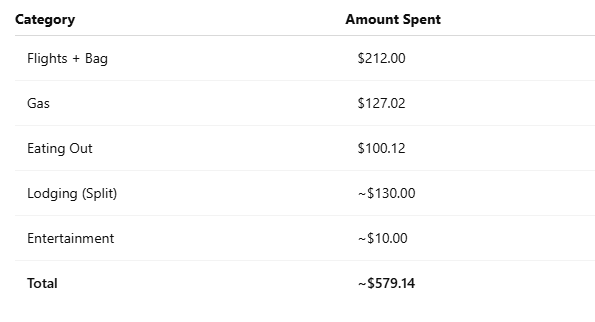
Smart Summer Travel on a Budget: How I Spent Less Than $600 Traveling Across States with My Kids
I believe everyone deserves a vacation—without going into debt to make it happen. In this post, I’m sharing how I traveled from Maryland to Ohio (and later to Georgia) with my daughters and stayed under my $600 budget. I break down exactly how I made it work—from using travel apps like Hopper and GasBuddy, to packing snacks, taking advantage of family lodging, and being intentional with every dollar. This trip reminded me how powerful planning can be, and how important it is to make room for rest, joy, and family—without sacrificing your financial goals. If you’re looking to travel smarter and stress less, this one’s for you.
Dynea Pope
7/14/20254 min read
Traveling during the holidays with kids and a limited budget sounds like a challenge—and it is—but it’s also possible with the right plan. Over the Fourth of July, I traveled from Maryland to Ohio with my daughters, coordinated their trip to Georgia with my parents, and made meaningful memories with my extended family.
My goal? Spend no more than $600. And guess what? I did it—and even came in under budget. Here’s how I made it all work while still enjoying every moment.
Be Honest About What Works for You
I left Maryland at 5:30 p.m. and arrived in Ohio around 2:30 a.m.—and quickly remembered how much I dislike long road trips. I knew I couldn’t handle another marathon drive to Georgia to pick up my daughters after their stay with my parents. So instead, I started researching flights early.
Flying Smart
I was able to book one-way tickets for:
$93 for myself
$32 each for my daughters
$55 for one checked bag
That totaled $212, far cheaper than driving—especially when you add in gas, food, and potential hotel costs.
Use Hopper to Find the Best Flight Prices
I used Hopper, a free app that tracks flight prices and tells you the best time to buy. It even sends alerts when prices drop so you can snag the best deal without guessing.
Know the Rules of Budget Airlines
Budget-friendly airlines like Spirit and Frontier can save you money—but only if you understand their policies. Many charge:
For both carry-on and checked bags
For choosing your seat
Extra fees for printing your boarding pass or changing flights
I budgeted ahead for the $55 bag fee and made sure I didn’t get hit with unexpected costs by reading the fine print first.
Use GasBuddy to Save on Fuel
Gas prices vary a lot depending on where you are. I used the GasBuddy app to find the cheapest gas stations along our route, which helped me plan fuel stops in advance.
Total spent on gas: $127.02Pack Snacks & Stick to a Daily Food Budget
Food can become one of the biggest money drains while traveling. To stay on track, I:
Packed a cooler with water, fruit, chips, sandwiches, and juice boxes
Set a daily food budget
Tracked what I spent each day
Total spent eating out (Wednesday–Sunday): $100.12
One of our few restaurant meals was a $26 brunch at Bob Evans with my immediate family.
Save on Lodging Through Family and Airbnb
The first night in Ohio, I stayed with my cousin for free. The next two nights, I shared a beautiful Airbnb with my sister and brother, which kept the costs low and allowed for more family time.
Tip: Sharing space with family or friends cuts costs and builds memories.Lean Into Family Events for Meals
We had several family get-togethers where meals were provided:
A BBQ at our family farm
A fish fry
A brunch at my aunt and uncle’s home
These gatherings helped me save on meals and brought us together around the table.
Entertainment on a Dollar Tree Budget
I stopped at Dollar Tree before the trip and picked up:
Bubbles
Small balls
Mini golf toys
These $1 toys kept the girls and their cousins entertained for hours—no screens or expensive outings required.
Use Work and Membership Discounts
Always check for work-related or membership discounts before booking or purchasing:
Employee discount portals
AAA, AARP, or educator discounts
Military or student rates
These can save you money on flights, rental cars, attractions, and more.
Don’t Forget the Hidden Travel Costs
When flying, plan ahead for:
Airport parking or rideshares
Baggage fees
Food at the airport
These often-forgotten costs can sneak up on you and throw off your budget if you’re not intentional.
Set a Clear Budget Before You Go
I went into this trip with one clear goal: Spend no more than $600.
To do that, I broke my budget down by category—gas, food, lodging, flights, and fun—and tracked expenses daily to stay on course.
Why It Was All Worth It
This trip wasn’t just a getaway—it was a reunion. My grandparents turned 78 and 79, and I was able to celebrate with them alongside family I don’t often see. These moments are precious, and I want my daughters to know their family intimately—not just through photos or phone calls, but through hugs, laughter, and shared memories.
Planning ahead allowed me to be present, not stressed. And that, to me, is the ultimate travel goal.
My Budget Breakdown
Budget Goal: $600
Actual Spend: Under budget!
Bonus Tips to Stretch Your Travel Budget
Use Hopper to track the best times to buy flights
Download GasBuddy to find the cheapest fuel
Know your airline’s bag and ticket policies
Set a daily food budget and stick to it
Take advantage of family meals when possible
Look for free or low-cost events at your destination
Always check for discounts through work or memberships
Budget for hidden costs like airport parking, Uber, or luggage fees
Split lodging and meals with family or friends
Create a sinking fund to save for vacations over time
Final Thought: Budgeting Is Freedom, and Rest Is a Right
We work hard—and we deserve rest. Vacations shouldn’t be something we finance with stress or credit. That’s why creating a sinking fund—a dedicated savings bucket just for travel—is key. Putting aside a little each month gives you peace of mind when it’s finally time to hit the road or book that flight.
And if your budget doesn’t allow for big trips, don’t count yourself out.
There are hidden gems right in your local area—parks, museums, day trips, and local festivals—that can offer fun and rest without the big expense. Being intentional with your money opens the door to opportunities that don’t require going far to go deep.
A solid travel budget isn’t about restrictions—it’s about freedom. Freedom to say “yes” to what matters, freedom to make memories, and freedom to enjoy the moment without guilt or debt.
Plan ahead, give yourself permission to rest, and travel with purpose—because the best investments are the ones we make in time well spent.




© 2024. All rights reserved.


Baltimore, MD 21236
Phone:(443)584-6723
Email: moneynomicsinfo@gmail.com


